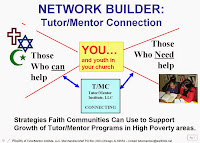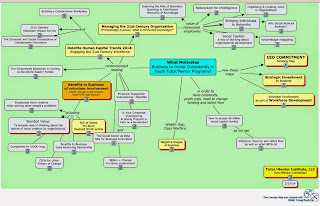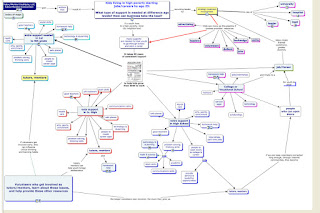Who would have thought that one man, surrounded by a small group of supporters who had little wealth or civic power, could have started a movement that now has hundreds of millions followers in all parts of the world. As you celebrate your religious holiday this week, I encourage you to think of what it takes for movements to grow to the size where they have impact.
Here and here are a couple of links to web sites showing spread of religions of the world.
Now, as you look at this growth, think of how we might growth the number of people from different sectors who are working consistently to help children born in high poverty neighborhoods move through school and into jobs out of poverty by the time they are in their mid-20s.
Most of the articles I’ve written over the past 20 years focus on this network building effort. I value volunteer-based tutoring/mentoring not just because of the impact mentors can have in the lives of kids, but because of the way structured, well organized, and well-funded, programs have the ability to attract a growing number of volunteers who devote their own time, talent and dollars to helping kids in poverty.
Unfortunately there are too few of these organizations, and even less that focus on transforming what volunteers do to help kids. There also is a lack of funding for data collection and analysis that would help build a better understanding of what programs are available and how they differ from each other.
Obtaining consistent funding, talent, technology and leadership for program growth, and intermediary roles, is the most limiting factor in making more mentor-rich programs available in high poverty neighborhoods of Chicago and other parts of the country.
Thus, finding ways to engage more people in learning communities focused on this problem is critically important. As you celebrate your faith holiday this week, I hope a few of you will reflect on this.
I’ve been trying to engage a growing number of people in this conversation since forming the Tutor/Mentor Connection in 1993. I’ve created a library of information and ideas that could be used to support the learning and involvement of people from every religion and every industry sector. This library points to more than 2000 web sites, reflecting the ideas of leading thinkers from around the country, not just my own ideas. I've been writing this blog since 2005 to share this information and draw people together to support the growth of mentor-rich programs in Chicago.
I’m not the only one who is trying to do this. Part of my library points to collaboration and community building work being done by others. We can learn from each other. We can connect our efforts.
This week I found a blog article written by Julian Thompson of the Action and Research Centre (RSA) in the UK who describes lessons learned from a project titled Valuing Your Talent (VyT)
He wrote, “The goal of the challenge, called Valuing Your Talent (VyT), is to increase the skills of the UK’s workforce, organisations’ performance, and societal value by helping employers get better at understanding and investing in their human capital. It’s based on an underlying conviction that employers and employees should better recognise their respective value, and have each others’ long-term interests at heart, as well as those of wider society. Central to this is investment in each other’s learning and development, and the ability to tackle important problems.”
In describing challenges, Julian wrote
“Achieving diverse participation is hard.
Building expert community participation from scratch, among people from very different disciplines takes time. It also takes continual awareness raising, active facilitation and responsiveness.
So far this has been more of a struggle than we anticipated.” In describing why senior business leaders are not getting involved he write “that it’s partly a cultural leap for them to engage in something like this, but partly a difference in motivation. They just don’t see the issue as much of a priority, compared to the HR folks. The same goes for the business owners and management in some cases, though others seem keen (but just too busy!).” (Read the article to see full description of challenges.)
In another article, this time from Monday’s edition of Crain’s, the title was “Why can't anyone make money in hyperlocal news?”
Businesses have not yet figured out how to make money from community benefit web portals, despite investment of millions of dollars, thus after a few years these initiatives disappear or are dramatically down sized.
Thus, how can any initiative focused on social and/or environmental issues ever succeed in multi-year efforts (decades?) intent on engaging people in ‘movement building’ proportions?
More than 10 years ago a VP from a big financial services company said to me, “You’ve got to be more creative in how you do business since you don’t have the money we have to invest in problem solving.”
Since I’ve been trying to draw visitors to the ideas and the information the Tutor/Mentor Connection has been aggregating for over 20 years, I’ve developed quite a few creative ideas that I feel could draw people together in face to face and on-line communities of practice, and that could draw volunteers and donors to tutor/mentor programs in all high poverty neighborhoods of a city like Chicago.
I focus on getting the attention and involvement of business leaders, because employee involvement in well-organized, on-going tutor/mentor programs is a benefit to current employees, not just to future employees. Leaders who realize this value should be more strategic in how they use company resources to support the growth and operations of such programs.
Below are a few visualizations I’ve created to show why business should be strategically involved with volunteer based tutor/mentor programs. In many of the nodes on the map I point to a web library with articles available for deeper learning.
I hope RSA and others who are trying to engage business leaders will use in their own efforts.
This map illustrates strategic reasons business should encourage volunteer involvement in tutor/mentor programs.
Here's the link to this map. Follow the idea path and see how this suggest benefits to the company from employee involvement and from involvement of part time employees in paid roles with youth serving organizations.
This graphic illustrates that companies in every industry need to be supporting tutor/mentor programs in every part of the city. This would result in multiple channels of revenue for every program and a diversity of workplace experiences being mentored in every program. For kids living in highly segregated neighborhoods (based on race and poverty) this type of mentoring program can connect kids to experiences and opportunities similar to what kids in more economically diverse neighborhoods experience naturally.
While there are numerous articles business leaders might read to engage in this thinking, this map shows a selection that could be used as a starting point.
While Google and other search engines have developed technology that enables you to find information if you know what you are looking for, I’ve yet to see a tool that maps problem solving, the way engineers and architects use blueprints to show steps toward building a product or a building.
Maps like the "Mentoring Kids to Career" map shown below can be linked to wiki pages or web site libraries which host links to web sites related to each node. New information can be added on a regular basis. MOOCs, Google Groups and similar on-line communities can stimulate learning around any set of ideas on the blueprint, or create a high level discussion of “everything” that needs to be happening concurrently in a community.
Building on-line discussions around these blueprints can help people from different places connect with each other. Place based conferences can draw visibility to the on-line libraries and help people and ideas connect in different places, drawing media attention needed to help keep the movement alive and giving recognition and awards to those providing leaders, funding and bringing new ideas to the sector.
Finally, GIS mapping and Social Network Analysis can help us understand who is participating in these events, and where they are located so we understand who else needs to be motivated to be involved.
We might some day see a world map showing growth of leadership and on-line communities of people working strategically to end poverty, solve environmental and health issues, improve wealth distribution and business habits and improve the well being of people throughout the world?
These are tools and ideas that need ownership by many people in many places. I hope to be invited to participate in forums hosted by others to help them understand how these graphics are intended to be used.
At the same time, I realize that too few people really understand what I’m talking about. Thus, I seek partners, investors and volunteers who will help me keep developing these tools, under the “If we build it, they will follow” thinking that most entrepreneurs have used to change the world.
Since 2005 interns from various colleges have help me communicate these ideas through their own writing and visualizations. Visit here and here to see work that has been done. If you think you can present this message with more clarity, interest and impact, I encourage you to reach out and offer your help.
Perhaps that’s what the motivating force was among the leaders who launched each of the religious movements that we celebrate this week.
Monday, April 14, 2014
Subscribe to:
Post Comments (Atom)

















No comments:
Post a Comment